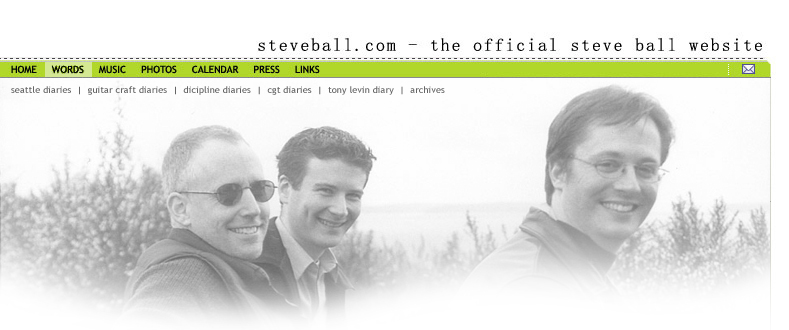Monday December 08
SBRS rehearsal chez TravisM - nice to see his 'new' place. And nice to
plug into our 2003 repertoire once again in preparation for upcoming shows.
* * *
Tuesday December 09
Had lunch with guitarist and developer Andrei Kozlov today in building 50 cafe -- also ran into Bob and Eve in the cafe, and
Andrei took these shots with his bazillion pixel digital camera:

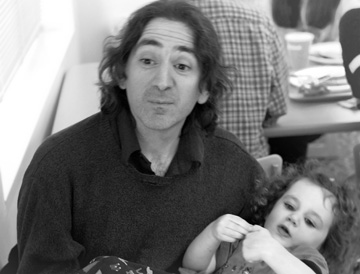
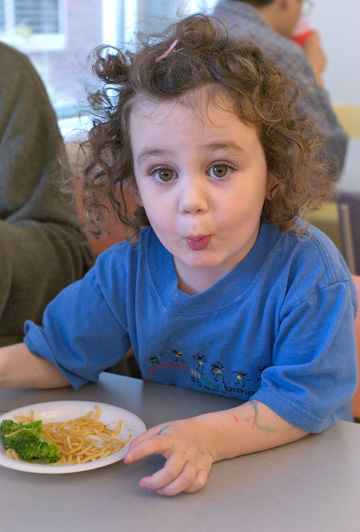

* * *
Wednesday December 10
Wow. Long long day, and I still don't feel well. Flu schmu. Not sure what
it is, but I feel terrible. Plowing ahead as best I can despite
being way under the weather.
* * *
SGC rehearsal brought some new discoveries this evening in how to communicate in
improvisations and Group Loops. More on this later in the week as we
continue to refine the work we initiated this evening in formalizing performance
techniques for intelligent group mprovisation.
* * *
Thursday December 11
Evening Rehearsal with TravisH for tomorrow's art show. JoelP worked
furiously to help hang the large Knotwork CD cover art and assorted other
Knotworks.
And Travis and I refined our performance techniques in building 3 hours of
ambient, textural, loop-based music for the show tomorrow evening. A
satisfying rehearsal. It is clear that we have 2+ years of working with
the Roadshow "in the bank."
* * *
Friday December 12
Evening: Seattle Art Show with 3 hours of improvised music by Travis Hartnett
and myself. Great to be performing with TravisH again. Some
high points during our three hour improvised show.
And afterwards, exhaustion. Mounting the artwork portion of the show plus
preparation for the performances, plus a nasty flu made this a rather unusual
week.
* * *
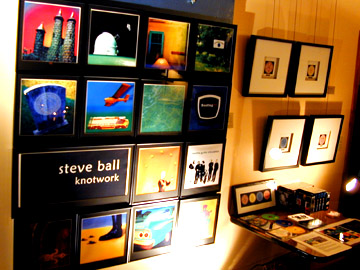
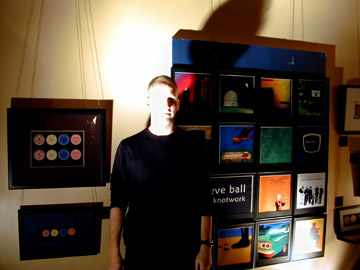
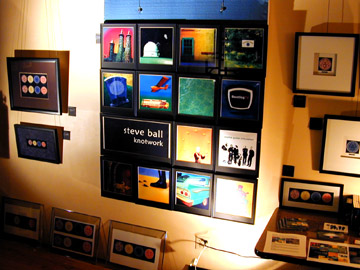
* * *
Saturday December 13
Decided to forgo morning guitar activities to spend my time resting and
preparing for a long afternoon of public performance. Also took some time
this morning to articulate some thoughts on upcoming SGC performance practices.
Sent this out to the SGC performance team this morning:
----- Original Message -----
From: SB
To: Taylor Sherman
Cc: Andrew Boscardin; Joel Palmer; Travis Metcalf; Sandra Prow; Curt Golden;
Lee Silberkleit; Paul O'Rear; Stephen Golovnin; Greg Meredith; Bill Rieflin
Tobin Buttram; Jaxie Binder; Dean Jensen; Derek DiFilippo; Chris Gibson; Bob
Williams;
Sent: Saturday, December 13, 2003 9:11 AM
Subject: Re: SGC Schedule: this Week and Next Weekend
Hi Taylor -
Not sure about rehearsal plan for this morning. I'm staying home to rest
after a long week and long night last night and 3 hours of playing to do
this afternoon. But even though you missed Wed rehearsal, I hope you can
make it today.
Here are a few things to review about the Seattle Art Show
performance today (and a few things to set the stage for shows next year):
a. load in at 12:30 to 2424 1st Ave south. There is no
place to store things so please travel light.
b. show is acoustic, no cables etc needed
c. dress code = black
d. Those who missed Wed evening reh, please ask Joel / Lee / Sandra / Paul /
Travis or someone who was there about the following:
Common Practices for Improvisations and Group Loops
1. "Calling key"
- always implies 'minor' and any note in minor 7th chord of the called key
is considered consonant. Or minor pentatonic. Ex. "C" = C, Eb, G or Bb --
these are the 'consonant' notes for Drone, Vamp, or Ostenato.
2. "Transitions"
- always occur with announcement of change key, or interval shift followed
by 1, 2, 3, 4 count to indicate when to change.
3. "Drone"
- each player plays one single note repeated forming a cluster or chord
(chord if a key is called, cluster if one is not.) It is each players job to
listen and change their note if their note is not 'consonant' with the
current tonality being played -- NOTE: 'consonant' does not imply 'major
triad' -- it implies 'harmony' with the tonality represented and might mean
any note from a whole tone scale.
4. "Vamp"
(we had called this an "ostenato", or continuous variation) - in old school
GC terms, this is 'vamping' that is playing two notes over and over again
from the minor pentatonic of the current key.
5. "Ostinato"
- this is "vamping" on a 3 note pattern instead of two
6. Group Loop
ending: preceded by a 4,3,2,1 count and the last note
is a down beat on the 1 of the next measure.
7. "Volume Circulation"
- whole group sets volume to 3/10 and each player plays their phrase at 8/10
for four measures, then next player moving left to right plays their part at
8/10.
Group Loop cues:
8. "Circulate Out" -- players drop out 'one at a time' (slowly)
in order of the circulation; this is also the effect of "Circulating In"
silence
9. "Key Changes"
-- when Calling Key, be very careful about enunciation; B, C, D, E, G all
sound the same if you whisper or are lazy in your enunciation; over the next
year, I hope to develop a series of key words and hand gestures to clearly
indicate modulations. If in doubt about which key was called, ask out loud.
10. "Follow the Leader"
- this is a special Group Loop where the group plays a sort of
'analog delay' game. Each person is to play exactly what the person
to their left is playing 6-20 seconds AFTER they play it. "Delay Time" is
called by the first leader.
Warm-Up Show Opening Improvisation
11. in our "Warm Up" improvisations: a. begin
with a 2 - 4 minute 'drone' on the root of the key that is called. Don't
rush in to noodling left hand exercises. Noodling = bad. Let the group
texture unfold slowly and naturally. The 'drama' and point of interest in
beginning a performance this way is not in making a big show or blowing
people away with some allegedly incredible piece of music, but in
confidently playing a very slowing evolving texture, and letting that be
enough. This beginning is the 'curtain' that sets the stage for the unusual
show that is to follow. Don't worry that the "curtain" is all one color or
takes 3-20 minutes to unfold and open. Let it be okay if the audience gets
bored or uncomfortable. Let it be okay if this is not the normal kind of
'song' that an audience expects at the beginning of a show. We are tuning
the room and the group, clearing the palate with a form of musical 'pink
noise.'
b. begin and end with intention, assertiveness, and confidence. Don't let
the audience know that this is not a 'pre-composed' piece.
c. focus on providing static textural patterns that complement what is going
on; less is more; one repeated sixteenth note played confidently with good
tone and that harmonizes with the group is 100x better than a fast noodly
arpeggio or melodic wank
d. avoid 3rds but if you must use them, then use very sparingly; if some one
is playing a minor third, don't play a major and vice versa; be wary of all
1/2 step placements - if someone is playing a minor second, respect that and
follow that convention
e. use dynamics and subtle harmonic shifting to give the 2-20 minute
'composition' an interesting, unfolding landscape; if you can't hear what
you're about to play before you play it, stick with roots and simple warm
ups. If you can hear, listen and follow each other harmonically -- even if
it moves to a whole tone, symmetrical, harmonic minor, or shifting set of
harmonic changes. If in doubt, stay on the root and play a very simple drone
or vamp. If in doubt, play less, but keep playing confidently.
Circle Communication
12. Speak with confidence and volume -
do not whisper - if you have an instruction or a count in, or a key change
to announce, say it loudly and clearly so that everyone in the circle can
hear you;
13. Cueing cutoff of the sustained chord at
the end of a piece - avoid the overly
dramatic and useless downward movement of the headstock to indicate when to
cut off a piece. If in doubt, let the last chord ring. If you need to
indicate when a piece ends, discuss it in rehearsal, and get everyone to
learn on which beat they need to dampen their strings. If in doubt, look to
the 'leader' of the piece and watch what his right hand does to end the
chord. (a la Andrew's excellent example last wed.)
14. Look up, out, and around--
do not stare at the floor - especially at the beginning and end of pieces!
Make real eye contact with each other in the group. No need to fake smile or
chat with each other while we play, but keep your eyes, gaze, and attention
up and focused on the other people (players and audience) in the room. At
the end of a piece, make contact with the 'leader' of that piece to watch
for cues about how and when to end together, when to release and drop hands,
and when to 'release' the piece to the audience.
15. Listen
- there is only one 'rule' about 'what' to play (even in GC repertoire):
play that which sounds good. If the group dynamic is moving to ppp muted,
then go with it. If there is a growing crescendo, go with it. If the piece
moves to minor from major, listen and go with it. If someone adds a new
'phrase' you've never heard before in a 'classic' piece of repertoire, don't
react with shock and horror, Listen and go with it. If someone plays a 'bad'
note, do not react - let it go and forgive them.
16. Circulating
- divide your attention between the person you are receiving the note from
and the one you are passing to. Watch the right hand of the person from whom
you are receiving the note to see when it is played rather than waiting for
some exaggerated body cue. Avoid overly physical turning and "passing"
motions in circulation. Subtle 'passing' motion is all that is necessary,
and that comes from fretting a note and plucking one string.
* * *
Okay, enough for now.
See some of you later today!
-Steve
* * *
Some photos from the Seattle Art Show performances:
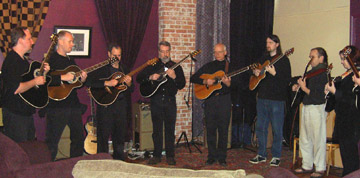
Seattle Guitar Circle Performance Team
Note the subjective interpretation of "dress code = black"
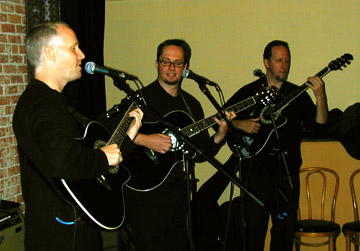
SB Roadshow with Curt Golden back in the lineup
* * *
Sunday December 14
A much needed day off following an demanding and draining week of doing. * * *
home
Monday December 15
Back to work today, catching up on low energy post-show and post-flu and piles
of open-ended correspondences.
* * *
Tuesday December 16
Evening: a Seattle Art Show post-mortem meeting with a discussion
about what did and did not work for our shows last weekend. A clear and
honest discussion among participants. And a sense of trust in the room.
It takes a certain maturity and detachment to be able to critique one's own work
and alleged project successes and failures.
At Microsoft, 'post mortems' are a standard part of a project completion - these
are (often brutal and honest) meetings where those involved are asked to
analyze, revisit, and measure how and what happened so that the group might
learn to be more effective next time around.
In a hierarchy, these meetings can be effective because there is a clear
meritocracy and system for measuring success based upon 1) who reports to who (ie
who puts the cash into my paycheck) and 2) even more importantly, who and how
many people bought my product (also directly related to whether there is money
in my paycheck.)
In a subjective, creative and/or artistic project where cashflow and business
hierarchy are not part of the dominant motivating parameters, the rules are
different. However, there is still often an unspoken system or hierarchy
of credibility and authority-based criteria by which performance (even
subjective performance) may be measured.
In Seattle Circle situations, the average group skin thickness is rather thin,
even fragile, so we rarely venture into 'post mortem' territory where
examination or analysis is applied with any sense of rigor or intensity.
Probably safer that way. However, I wish there were some way to engage
this community in more of this kind of more rigorous study of how we operate as
a group.
* * *
Wednesday December 17
This just in from my old friend, musician, Europa String Choir guitarist, Udo:
----- Original Message -----
From: "Udo Dzierzanowski"
To: "Steve Ball"
Sent: Wednesday, December 17, 2003 7:53 AM
Subject: Package & Happy Christmas!
Hi Steve,
Firstly, thank you sooooo much for the package, which arrived so soon after
I had ordered the CDs! I noticed that you put in 'Ballistic' to complete my
Steve Ball collection - what a star! Thank you very much - I was really
touched.
I have listened to the 'Roadshow' and really enjoyed it. Surprising, fresh.
I love it! It sounds really American in a good way. 'Greenthumb' took me
back to my own days (few they were) in an early Steve Ball ensemble
(remember the Claymont Barn gig?) before it was called Curtains. I was a
very different person then. It was good to hear these songs again - I still
think they have a particular power to them. I also noticed that you can hear
the enthusiasm of the 'early' keen Argentinans literally burst from the
speakers (if you see what I mean)! Great. 'Naive Melodies' is a very brave
undertaking! Only listened to it once so far - wow! Must listen more times
before making any comment. I liked Travis doing John Cale! Congratulations
to all of you for putting out such a comprehensive work of new material.
Still looking forward to listening to the 3rd CD!
That reminds me, can you give me Travis M's email address - he gave it to me
in LM last year, but my Palm lost it's memory before I could sync it.... I'd
like to write to him.
As far as inspiration goes, you've already inspired the ESC to realease a 3
CD Box Set! Only an idea for now, but a good one! We are planning to bring a
re-release (Lemon Crash), a promo EP (RPD) and a live improv CD (still to be
released) into one 3CD box eventually. I think it makes sense. CD box sets
are the new LPs! Until online music completely takes over - but that may be
some time to come.
I hope you are well. Cathy and I would like to wish you a very happy
Christmas time and a successful, peaceful and happy new year 2004.
Lots of Love,
Udo
I'd completely forgotten about the 'pre-Curtains' group that Udo was in at
Claymont. Sounds like ESC has some cool projects cooking for next year.
* * *
Thursday December 18
Lunch in Building 9 with David Lavallee, Pat Rodden, and my old Windows shell
developer friend, Chris Evans. Showed David's
Instapix to Chris and we discussed
many issues around media acquisition, networking, and next generation
challenges. Good people, great conversations.
Too bad other ex-Apple pals Don Lindsay and Walter Smith could not have joined us too. Both
busy, but interested.
* * *
From the mailbag:
----- Original Message -----
From: Rieflin
To: Joel Palmer
Cc: Seattle Circle Board; Curt Golden; Tobin Buttram; Bob Williams; Jaxie
Binder; Dean Jensen; Chad Belgarde; Jim Gomez; Doug Brettin; Chris Gibson;
Sent: Thursday, December 18, 2003 3:36 PM
Subject: Re: call for SC Board meeting
Dear All,
I am unable to attend the Jan. 12th meeting. This doesn't mean I can't cause
some trouble beforehand.
As Joel is encouraging discussion of agenda items ahead of time, here is one
thing that caught my eye immediately: "Role of SC Board in defining &
setting direction."
My understanding (such that it is) is that the Board exists to execute the
bidding of the SGC, not the other way 'round. Is this so? Anyone care to
address this in a way that is not theoretical?
BR.
I'm not sure I can clearly address Bill's question via this diary in a way that
is not theoretical, however, the idea that "the Board exists to execute the
bidding of the SGC, not the other way round" does not completely resonate with
me.
In fact, I would argue that if it is operating honestly, the Board actually
exists specifically to execute the projects of those on the board who have
decided that they wish to sacrifice their time and energy work together to plan,
fund, enable, and sponsor exactly those projects they care about (which may or
may not resonate with the divergent needs of an alleged, amorphous, and often
disconnected community.)
If the will of the Board is not in line with the needs of the community
(audience) they 'serve,' then perhaps the audience has come to the wrong show?
But suggesting that the Board exists to 'serve the SGC' is something like saying
that the audience should determine the set list at a concert. I disagree -
if someone has a will to work and sponsor projects, then why are they not on the
board (or at least working with the active members on the board, driving and
actually contributing to the process?
Anyone in the SC community is invited to participate and be on the board.
However, the idea that this Board serves the vague, distributed, and
unaccountable entity known as 'the SGC community' is troubling in what it
assumes.
In my view, the work of the Board is to work together to facilitate the business
and project-oriented aims of the members of the Board. This is done, in
the best circumstances, with collaboration, feedback, and input from those who
do not have the time or interest in organizing projects or dealing with the
logistics behind organizing performance and educational activities in the world.
However, I often feel there is an unrealistic and somewhat naive impression
that, by definition, business and the structures that we adopt to conduct
business are somehow deemed to be 'evil' or to be avoided. None of
this is 'theoretical.' Produce and release a CD; plan,
sponsor, and deliver a course; book and host a high-profile show;
this is where these kinds of management 'theories' are tested. And
good luck doing any of these without a business structure that both defines and
drives these kinds of activities to completion with some measure of
accountability.
* * *
In what is left of this year, and in early 2004, I wish to clean up our
understanding about how and why we operate as we do within the SC and SGC.
The beginning of this process involves clearly defining the labels we use and
articulating our aims in simple, experience-oriented terms.
* * *
Friday December 19
Birthday dinner out with Bob and Jaxie at a Chinese restaurant that is in what
was obviously a Mexican restaurant (shaped like a Mexican hat.) Great
food, company, and conversation.
* * *
Saturday December 20
Up early for Calisthenics, sitting, breakfast and conversation with Travis,
Curt, Joel, Bill, and Sandra. The breakfast conversation was both useful
and compelling - we achieved some clarity about why there is ongoing confusion
about what the Seattle Circle and Seattle Guitar Circle does as a
individuals working in various groups.
Over the past few days, I've been visualizing a diagram that illustrates the
idea that SC and SGC work is actually happening simultaneously in nine areas
spread out across three distinct octaves.
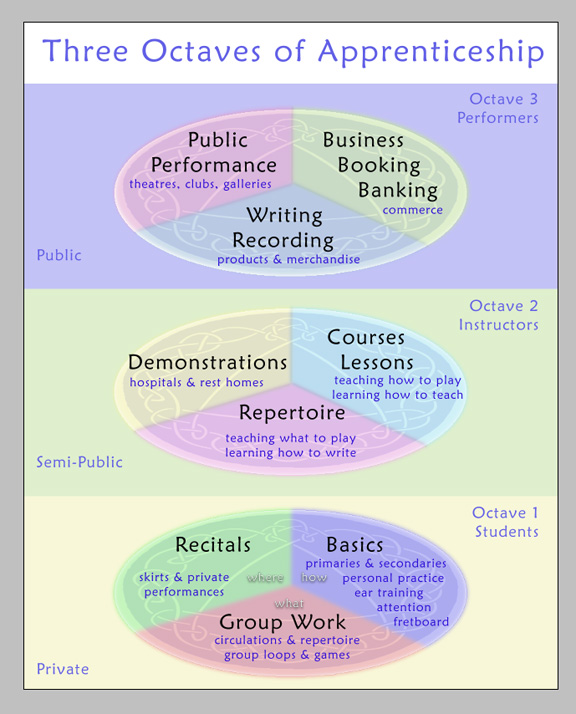
The three 'octaves' represent three centers of gravity within a chronological
process of apprenticeship to a school (in our case, Guitar Craft) where there is
a gradual progression from 'student' to 'instructor' to 'performer.' Those
working in 'octave 2' pull those working in 'octave 1' up and around each
spiral. In Fourth Way terms, the top and the bottom octaves blend
together to actualize the middle, where the most intense activities of the
Guitar Craft school occur, not too removed from our daily lives but not totally
immersed in or absorbed by the outside world.
There are three segments of tasks and activities in each "octave," each of which
has a distinct and unique purpose, function, and flavor (1. how to do, 2. what
to do, and 3. where/when to do.)
Within the Seattle Circle community, one of our main problems as a group is that
we often assume we are all working on the same stuff at the same time,
and all of these distinct activities get schmooshed down into one assumed
'common' process. In fact, at any given time, it is probably an
illusion that we share the same aim or require the same specific 'tasks' to meet
our aims, when, as shown here, there are at least 9 distinct categories of
overlapping, but distinct activities going on in Seattle.
Taking this further, if you analyze and "bucketize" the projects we've been
doing for the last 2-10 years here, they generally fall into categories of
activities that line up nicely with the diagram above:
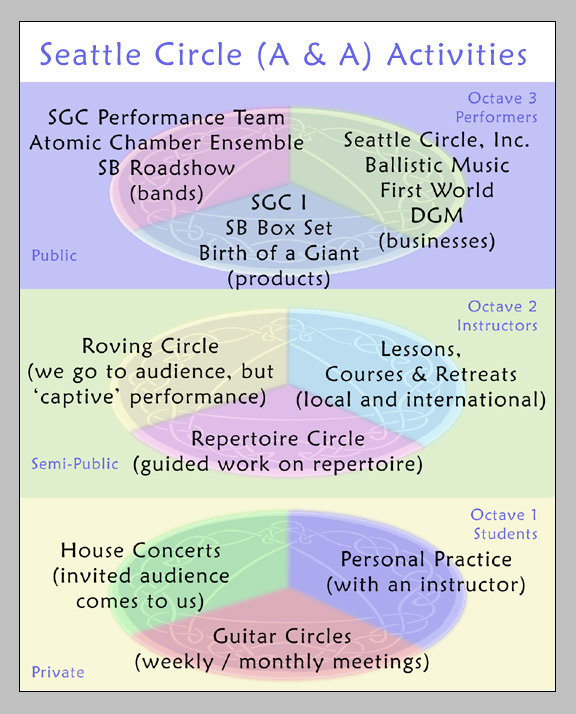
The specifics listed above are only a small subset of the activities and
entities that have manifested within the greater Seattle Circle community.
And yet, until recently, we have lacked any framework or common language that
would enable us to articulate, describe, or discuss how our diverse aims and
interests all fit into this bigger picture and process of ongoing apprenticeship
to Guitar Craft.
These 'renderings' are by no means perfect or definitive (in fact, I already see
some things I would redefine and move to make this more accurate), but for now,
I hope that they might give us an additional tool to discuss how and what we
wish or need to do in the next period to clearly define our aims for ourselves
in context of the larger process that is going on around and within us.
* * *
Some definitions
Seattle Circle, Inc. is a non-profit corporation whose mission is to
develop and promote appreciation of music in the Puget Sound area through
education, workshops, and performances. This will be achieved by providing
a professional facility and an educational atmosphere for the enhancement of
skills in the field of music. Seattle Circle provides instruction on both the
individual and group level and presents the results of our work the the public
through performances, workshops and presentations.
The Seattle Circle community is the body of students, instructors and
performers who share the common aim of working together to realize the above
stated mission.
On any given day, the Seattle Guitar Circle is the primary active working
body of guitarists within the Seattle Circle community. In public
performance, the Seattle Guitar Circle is the front line performance team
representing the extended Seattle Circle community.
* * *
Afternoon: the first official 'Seattle Guitar Circle' guitar
circle meeting of 2004. An inspiring, creative, and musical 'intentional
circulation' session with the same six who were at the sitting and breakfast
this morning.
* * *
Sunday December 21
Largely, a day off with some business plan writing in the afternoon in
preparation for the new year.
Evening: film "The Last Samurai" - not bad.
* * *
home
|
